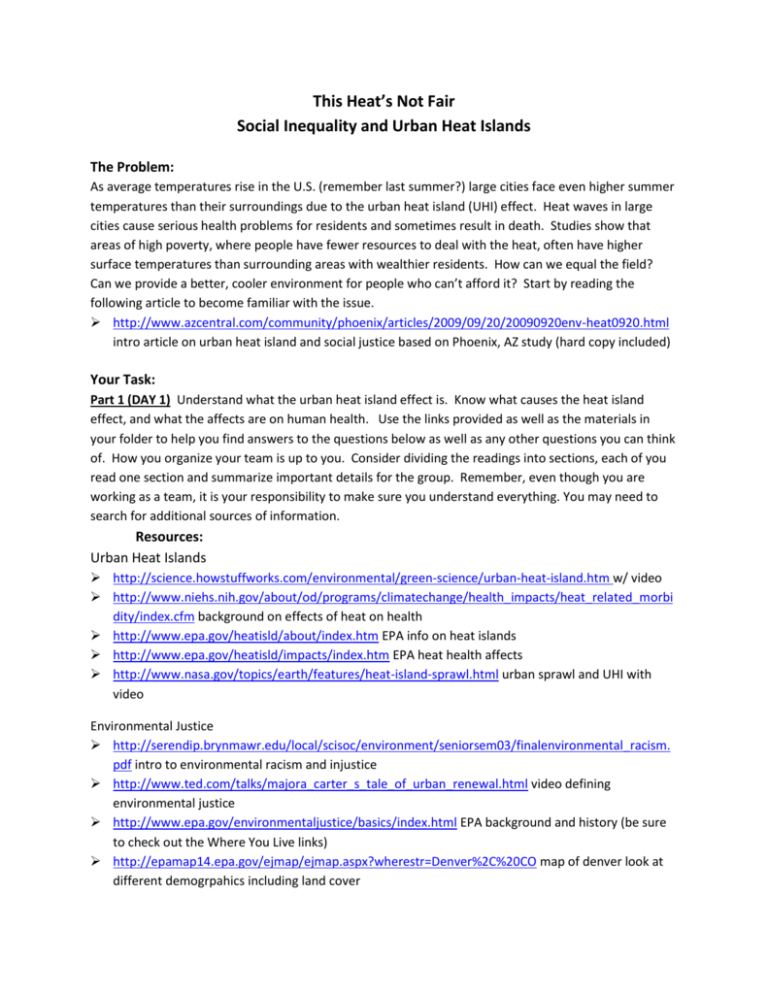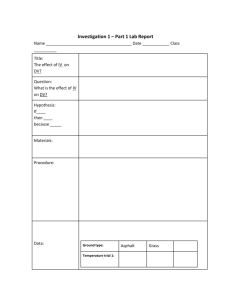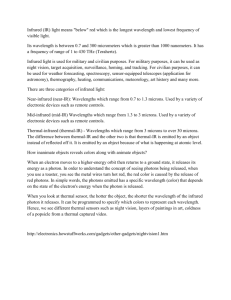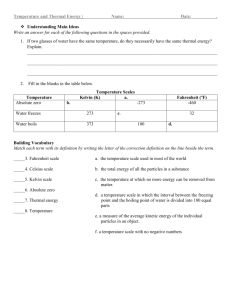CaseStudyHeatIslands - UCAR Center for Science Education
advertisement

This Heat’s Not Fair Social Inequality and Urban Heat Islands The Problem: As average temperatures rise in the U.S. (remember last summer?) large cities face even higher summer temperatures than their surroundings due to the urban heat island (UHI) effect. Heat waves in large cities cause serious health problems for residents and sometimes result in death. Studies show that areas of high poverty, where people have fewer resources to deal with the heat, often have higher surface temperatures than surrounding areas with wealthier residents. How can we equal the field? Can we provide a better, cooler environment for people who can’t afford it? Start by reading the following article to become familiar with the issue. http://www.azcentral.com/community/phoenix/articles/2009/09/20/20090920env-heat0920.html intro article on urban heat island and social justice based on Phoenix, AZ study (hard copy included) Your Task: Part 1 (DAY 1) Understand what the urban heat island effect is. Know what causes the heat island effect, and what the affects are on human health. Use the links provided as well as the materials in your folder to help you find answers to the questions below as well as any other questions you can think of. How you organize your team is up to you. Consider dividing the readings into sections, each of you read one section and summarize important details for the group. Remember, even though you are working as a team, it is your responsibility to make sure you understand everything. You may need to search for additional sources of information. Resources: Urban Heat Islands http://science.howstuffworks.com/environmental/green-science/urban-heat-island.htm w/ video http://www.niehs.nih.gov/about/od/programs/climatechange/health_impacts/heat_related_morbi dity/index.cfm background on effects of heat on health http://www.epa.gov/heatisld/about/index.htm EPA info on heat islands http://www.epa.gov/heatisld/impacts/index.htm EPA heat health affects http://www.nasa.gov/topics/earth/features/heat-island-sprawl.html urban sprawl and UHI with video Environmental Justice http://serendip.brynmawr.edu/local/scisoc/environment/seniorsem03/finalenvironmental_racism. pdf intro to environmental racism and injustice http://www.ted.com/talks/majora_carter_s_tale_of_urban_renewal.html video defining environmental justice http://www.epa.gov/environmentaljustice/basics/index.html EPA background and history (be sure to check out the Where You Live links) http://epamap14.epa.gov/ejmap/ejmap.aspx?wherestr=Denver%2C%20CO map of denver look at different demogrpahics including land cover 1. 2. 3. 4. 5. 6. 7. 8. 9. Questions: What causes heat islands? Why do they happen in urban areas and not rural? Is the problem day time or night time temperatures? What materials worsen the effects? Lessen the effects? Why should we worry about UHIs? Who is affected the most by UHIs? What is environmental justice? Why do poor people suffer negative environmental affects more than wealthy people? Who is fighting for environmental justice? What earth spheres are affected by this issue? Give examples of how changes in one sphere affect other spheres. Part 2 (DAY 2) – Become an expert Complete the It’s All About Image student activity (hard copy included) Part 3 (DAY 3) – Data Analysis Part 4 (DAY 4) – Recommendations Now that you have some evidence that black carbon increases the rate at which ice melts, what are you going to do about it? Time to save the polar bears. Make a list of recommendations for reducing the amount of black carbon that reaches the arctic. Use the information and data you have collected to create convincing options that the rest of us (and the world) can buy into. You will share your results in a brief presentation to the class. Create a Prezi or PowerPoint using the following guide: Presentation length (8-10 minutes) o 2 minutes – background o 2 minutes – what you learned from your data analysis o 4 minutes – your recommendations and why they would work o 2 minutes for questions Each member of your group must participate in the presentation Be clear so others can get a good overview of your case study Write 2-3 clicker questions to be used both before and after your presentation to gauge the feelings and opinions of your audience. This should provide you a measure of how your presentation informed you audience and changed their perceptions. These could be multiple choice, short answer, or likert scale. http://www.heatislandmitigationtool.com/Inputs.aspx?t=1 mitigation screening tool (includes boulder but not denver) Study: Wealth buys rescue from urban heat island By Shaun McKinnon - Sept. 20, 2009 12:00 AM The Arizona Republic Heat discriminates. Phoenix's sweltering summer inflicts the most misery and illness in poor neighborhoods, a new study shows, and among people least able to protect themselves from the elements. Conditions in those neighborhoods, with their sparse landscaping, high-density housing and converging freeways, create pockets of extreme heat that persist day and night. Inside, homeowners sometimes can't afford to turn up - or even turn on - the air-conditioner. Wealthier homeowners, meanwhile, often in neighborhoods just blocks away, maintain lush yards and trees that help cool the air more quickly at night, shortening the hours of the hottest heat waves. They can buy further relief with a nudge of the thermostat. The disparities present threats more serious than just discomfort on a hot day, according to the study, produced by Arizona State University researchers. Prolonged exposure to heat can cause illness or even death. The densely developed nature of the hottest areas also means more of the people most vulnerable - the elderly, children, the homebound - live in the neighborhoods where the risk is greatest. That link between money and the ability to cope with extreme weather emerged clearly in the research. Among the startling revelations: For every $10,000 an area's income rises, the average outside temperature drops one-half degree Fahrenheit. "It's an environmental-justice issue," said Darren Ruddell, a geographer who led the study. "The people who are most vulnerable are also living in the worst conditions. It's a double whammy." The researchers say they hope their findings will spur discussions about better managing land, water and energy use, factors that will grow more critical if temperatures rise in coming years, as climate-change models predict. "If we can identify the areas most at risk, we can try to help them," Ruddell said. "We could redesign neighborhoods, build cities differently, improve warning systems and ultimately reduce our vulnerability to heat." The heat islands Scientists have long known about the effects of the urban heat island, a phenomenon that occurs when buildings and roads absorb energy from the sun and then release it slowly when the sun sets. That keeps temperatures higher at night and speeds the warm-up the next day. In metropolitan Phoenix, the heat island is most apparent in the urban core, the effects ebbing in the suburbs. What Ruddell - a post-doctoral scholar splitting his time with ASU's Central Arizona-Phoenix Long-Term Ecological Research project and the Decision Center for a Desert City - and sociologist Sharon Harlan - an associate professor of sociology at ASU's School of Human Evolution and Social Change - depict in their research is more like a string of heat islands, with cooler neighborhoods sandwiched between the hottest areas, even in the urban core. One of the key differences is the land cover. The hottest neighborhoods were also the most barren, with homes surrounded by asphalt or dirt. Slightly cooler were xeriscaped areas, usually a mix of landscaping rocks and a smattering of shrubs or trees. Cooler still were areas in natural desert, usually near mountains. And the coolest neighborhoods were planted with grass, shrubs, flowers and shade trees. For their research, Ruddell and Harlan decided to focus on a 96-hour heat wave in July 2005. As it happened, that summer was a scorcher: 31 people died from heat-related ailments in a span of less than six weeks, but the dates were selected using more precise data. Using historical climate data and weather records, the researchers established 113 degrees as a so-called threshold level to define an extreme heat wave. The highs in the July 2005 period ranged from 113 degrees to 116 degrees. Working with actual temperature readings and interviews with residents in the targeted neighborhoods, the researchers determined how many hours the residents were exposed to the hottest temperatures. In the most barren urban neighborhoods, residents were exposed to almost 22 hours of the intense heat. In the xeric areas, the exposure was about 16 hours. In natural-desert areas, the exposure dropped to six hours, and in the lushly landscaped areas, residents suffered just four hours of intense heat. What Ruddell discovered was that in many cases, the land cover and the types of landscaping mattered more than the geographic location of the neighborhood. Residents in the hottest neighborhoods were more likely to be poor and their homes more likely to be located near the inner urban core, but the exceptions were striking. Some of the neighborhoods with the most hours of extreme heat were farther out from the inner core in areas that should enjoy cooler temperatures based on the idea that the heat island develops in the middle of the city. But these areas were so new, they lacked mature landscaping and wound up warmer than expected. "These are increasingly stressed fringe areas that are not as comfortable because of sparse landscaping and poor land quality," Ruddell said. "And they're mostly middle-class neighborhoods." The disparities Jim Puza doesn't need a study to tell him that heat kills or that the poor suffer during the months. As director of the Salvation Army's emergency disaster services in Phoenix, Puza spends much of his summer trying to help people survive. "We realized this was a bigger issue in 2005," Puza said. The rash of deaths among homeless, elderly and ill people brought non-profit groups such as Puza's together with cities and churches. "We decided to start treating this thing like any other natural disaster we might have," Puza said. At first, efforts focused on the homeless, who often lacked access to a cool building or a bottle of water. This summer, the Salvation Army expanded its outreach to lower-income residents, homebound seniors and the disabled. "It's been exacerbated by the economic disaster we've had," Puza said. "People have to choose with what little money they have between turning the AC on or putting food on the table." The ASU study revealed how severely heat can target lower-income residents and subject them to heat-related illnesses. Harland and Ruddell divided the 40 neighborhoods they studied into three categories based on heat-intensity hours: high, medium and low. When they overlaid demographics, they found stark differences. Median household income in the hottest neighborhoods was less than half what it was in the lowand medium-intensity areas. People in the high-intensity areas were more likely to be minority, and they were older than the people in the coolest areas. "Wealth can buy options that let people change their indoor and outdoor environments," Harlan said. "They can bring in more landscaping, they can run the air-conditioning, they can move to cooler neighborhoods." Adapting to the heat Harlan and Ruddell are part of a larger ASU research team working with a $1.4 million National Science Foundation grant to study urban residents' vulnerability to heat. Still unanswered are some broader questions. "As we have changed to drier landscapes, people haven't been thinking about impact on heat and energy use in homes," Harlan said. "When you have a drier landscape in your home, you may be using more energy to cool down the indoor environment." The air-conditioner raises the temperature surrounding the home, and it also consumes energy that requires water to produce. That means the water saved by replacing grass with rocks and cactuses could be used up in the energy needed to offset the warmer neighborhood conditions. The findings could lead residents to rethink ideas about which landscape is best for Phoenix, said Ruddell. Perhaps a grass yard, with its cooling effects, would make more sense in the long run than the drier landscapes, favored for their supposed low-water use. "Using water to cool and support some more vegetation has certain benefits," he said. "Just converting to xeric may not be the best option. It's something we need to conduct further investigations on." Understanding the ways in which heat and land use interact could also help urban planners design neighborhoods in ways that stop heat islands from developing. Landscaped open space, roofs and building materials that absorb less heat and even the color of homes and offices could make streets more comfortable. Preventing the heat islands from forming could lower temperatures at night enough to reduce the draw on air-conditioners and the energy they use and the extra heat the units emit. Lower energy demands could, over time, help reduce greenhouse-gas emissions, which many point to as the driver behind global warming. In the short term, state, local and federal officials are trying to help people better adapt their surroundings to heat. Phoenix has spent about $1 million a year to help low-income residents weatherize their homes by sealing leaks in air ducts, adding insulation or even replacing old, inefficient air-conditioners. The federal stimulus bill added $7.2 million to boost the program for the next three years. But the ASU team believes desert cities will face bigger challenges to help people cope with rising temperatures. Researchers used long-term records to set a temperature threshold for the study, the rare point at which heat became extreme. Based on current data, that level is 113 degrees, Ruddell said, but it could climb in the future under most climate-change scenarios. "Perhaps in 1950, it was 108 and maybe it'll jump to 118 in the next century," he said. "We can't be sure yet. We need to better understand these forces." And Valley residents, as hardy a bunch as they may like to think they are, need to understand that heat is dangerous, no matter how green the neighborhood or powerful the air-conditioner. "There's a notion about Phoenix that we're all adapted to high temperatures, but I think people are beginning to realize that's not all true," Harlan said. "Our efforts to adapt won't protect us in terms of falling victim to heat illnesses." Read more: http://www.azcentral.com/community/phoenix/articles/2009/09/20/20090920envheat0920.html#ixzz21ThsIRMu It’s All About Image Student Activity Analyzing Thermal Images Altered from Arizona State University Ecology Explorers at: http://ecologyexplorers.asu.edu/docs/explorers/lesson_plans/5_its_all_about_image_lesson.pdf Background: Infrared is a type of light that we cannot see with our eyes. Our eyes can only see what we call visible light. Infrared light brings us special information that we do not get from visible light. It shows us how much heat something has and gives us information about an object's temperature. Everything has some heat and puts out infrared light. Even things that we think of as being very cold, like an ice cube, put out some heat. Cold objects just put out less heat than warm objects. The warmer something is, the more heat it puts out and the colder something is, the less heat it puts out. Hot objects glow more brightly in the infrared because they put out more heat and more infrared light. Cold objects put out less heat or infrared light and appear less bright in the infrared. Thermal infrared imagers are detector and lens combinations that give a visual representation of infrared energy emitted by objects. Thermal infrared images let you see heat and how it is distributed. A thermal infrared camera detects infrared energy and converts it into an electronic signal, which is then processed to produce a thermal image and perform temperature calculations. Thermal imaging cameras have lenses, just like visible light cameras. But in this case the lens focuses waves from infrared energy onto an infrared sensor array. Thousands of sensors on the array convert the infrared energy into electrical signals, which are then converted into an image. Facts about the Urban Heat Island In Denver: In the summertime, dark pavement surfaces may reach temperatures of 140ºF. Roofs can get to be 160ºF. 40% of the urban surface cover in Denver is pavement; only 15% of Denver’s urban surface is covered by buildings. The average nighttime low temperature in Denver has increased by 8ºF over the last 30 years. For the months of May through September, the average number of hours per day with temperatures over 100ºF has doubled since 1948. Nearly 6% of peak energy demand in the summer can be attributed to the rising temperatures of the urban heat island. In Denver, a pool loses the equivalent of its total volume every year through evaporation. Pools lose almost ½ inch of water per day in June and July. Objectives: Students will be able to : 1. describe the difference between a thermal image and a visible light image of the same object or scene. 2. determine the warmer and cooler areas of a thermal image by using a temperature scale. 3. describe why different parts of the built environment gain and release heat at different rates over the day. 4. describe the characteristics of an Urban Heat Island, a nighttime phenomenon. Vocabulary: infrared radiation - electromagnetic emissions responsible for heat, with longer wavelengths and less energy than visible light, but shorter wavelengths and greater energy than microwaves (from about 0.75 micrometer to 1000 micrometers) thermographic cameras - devices that capture images of infrared radiation thermal images - images of infrared radiation captured by thermographic cameras Urban Heat Island - A metropolitan area which is significantly warmer than its surrounding rural areas. A night time phenomenon of increased temperatures in the Phoenix Metropolitan area. Materials: It’s All About the Image part 1 It’s All About the Image part 2 (ppts can be found at: Procedure: 1) View the six different thermal images taken of objects with infrared cameras in It’s all about the image part 1. 2) Answer the questions below: What object is depicted in the thermal image? Record your inferences. How is this thermal image different than a “regular” picture? What do the colors mean? What part of the item in the thermal image is the warmest? The coolest? What special information do these thermal images provide that we don’t get from “regular” pictures? 3) Keeping in mind that each picture has its own temperature scale: What information can you get in a visible picture? What information can you get from the thermal image? Comparing one thermal image to another, what different temperatures are represented by the color red? yellow? blue? 4) Determine whether the IR photos in It’s all about the image part 2 are daytime or nighttime pictures. Describe the characteristics you used to sort the pictures. 5) Record your responses to the following questions: Which areas of the daytime images were the warmest? the coolest? Which areas of the nighttime images were the warmest? the coolest? Which surfaces stayed warmer in the nighttime images? Which surfaces cooled off in the nighttime images? Which images, night or day, appear the warmest? Why do some of the surfaces in the nighttime images retain their heat? Based on the images, how would you define the Urban Heat Island phenomenon? Homework: Have a smartphone? Download a free infrared camera on your phone and take pictures around the outside of your house. Take the same photo during the day and after dark to analyze how different building materials in Green Valley Ranch change temperature at night. Make sure your app is set so that yellow is hot and blue/purple is cooler. Which surfaces/materials stayed warmer in night images? Which surfaces/materials cooled off in the night images? Based on your images, how would you describe the urban heat island affect in your neighborhood?







